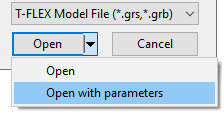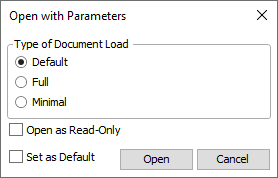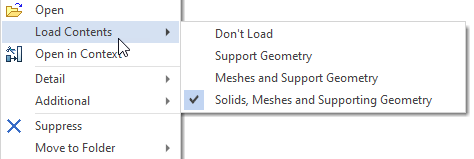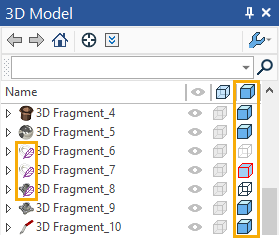Large 3D Assembly Management Tools |
  
|
To optimize working with assembly models, the system provides specialized large assembly management tools:
•Selecting a type of document load
•Partial loading of fragment's content
•Disabling the display of small 3D objects
Those allow working only with the subassemblies of concern, save the overall used memory and facilitate spinning the 3D scene when it is densely populated with objects.
Selecting a type of document load
When opening an assembly, you can select a type of load:


With the Default type, meshed representations of fragment bodies will be loaded instead of solid representation. Meshed representations speed up the loading process. With the Full type, the solid bodies of all fragments will be loaded. With the Minimal type, fragments will not be loaded, the assembly tree with fragments will be available to the user, but the 3D scene will be empty.
For more information about the settings when opening the assembly, see Open Model.
Each selected option affects performance. By default, as noted earlier, the fragments have meshes loaded, which allows you to see their visual display, and the support geometry is loaded, which shows the external objects of the fragments. If an assembly fragment is selected as an element of any modeling or measurement operation, bodies will be automatically loaded for it. You can force loading or unloading of bodies, meshes, support geometry of a particular fragment using fragment's contextual menu, as described below.
Partial loading of fragment's content
After loading an assembly, you can also adjust the loading method for each fragment - additionally load necessary elements or unload the extra ones. Following options are available in the Load Contents section of fragment's contextual menu:
![]() Don't Load
Don't Load
Only the model tree is loaded.
![]() Support Geometry
Support Geometry
The model tree, external support geometry, and 3D pictures are loaded.
![]() Meshes and Support Geometry
Meshes and Support Geometry
The model tree, external support geometry, 3D pictures and meshed representation of bodies are loaded.
![]() Solids, Meshes and Supporting Geometry
Solids, Meshes and Supporting Geometry
The model tree, all support geometry, 3D pictures, meshes and solids are loaded.

These options are also available in the special Load Contents column of the 3D Model and Assembly Structure windows. The column contains icons representing the type of fragment's content loading. Upon clicking the column, the drop-down menu appears, containing the options described above. If a fragment's content is loaded partially, its main icon in the model tree is also marked with the feather symbol.

Disabling the display of small 3D objects
In the Document Parameters command on the Large Assembly Management tab, it is possible to disable the display of small 3D objects using the Don't show parts smaller than parameter.

3D objects whose size does not exceed the specified value (in model units) will be considered small.